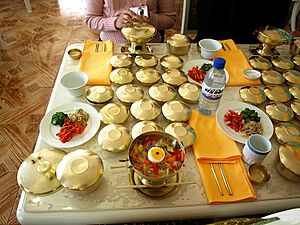Bangjja facts for kids
| Bangjja | |

Bangjja ware used to serve various food at a restaurant in Kaesong, North Korea.
|
|
Quick facts for kids Korean name |
|
|---|---|
| Hangul |
방짜 / 유기
|
| Hanja |
-- / 鍮器
|
| Revised Romanization | bangjja / yugi |
| McCune–Reischauer | pangcha / yugi |
| IPA | [paŋ.t͈ɕa] / [ju.ɡi] |
Bangjja (pronounced 'bang-jah'), also known as yugi ('yoo-gee'), is a special type of bronze metalware from Korea. It's made by hand-hammering, not just melting and pouring. A full set of bangjja usually includes dishes, bowls, spoons, and chopsticks.
What makes bangjja different from other bronze items is its unique mix of metals. It has a lot more tin compared to copper (about 78% copper and 22% tin). Most other bronze has much less tin. Because of this special mix, bangjja can actually clean itself and kill germs!
This amazing feature meant that bangjja was historically used as tableware for the royal families of Korea. It was perfect for serving traditional Korean royal court food, called surasang. In 1983, the government of South Korea officially recognized bangjja as an Important Intangible Cultural Property. This means it's a very important part of Korea's history and culture.
History of Bangjja
Bangjja metalware shows off Korea's long history and traditional style. Its story goes all the way back to the Bronze Age. Back then, people used bronze widely to make many different tools and dishes.
During the Goryeo dynasty (which was a long time ago in Korea), people often traded with China. Royal families and nobles used thin bronze tableware made with the bangjja technique.
Later, during the Joseon Dynasty, the country really supported mining. They even set up many metalware factories in different areas. While most people used porcelain dishes during this time, upper-class families kept using bronze items, just like in the Goryeo period. As time went on, even middle-class people started using more bronze dishes. This led to many markets for bangjja all over the country.
Sadly, near the end of the modern age, most bangjja in Korean homes was taken away by Japan. After Korea became free in 1945, bangjja became popular again. But then, after the Korean War, people started using stainless steel bowls more. This was because bangjja could easily change color from the gas given off by briquettes (a type of fuel).
Today, bangjja is becoming famous again! Scientists have done experiments and found that bangjja can kill certain bacteria like O-157. It can also fight off other germs and even detect pesticides. Plus, it stays warm longer than porcelain or stainless steel bowls. Nowadays, bangjja is used for making musical instruments, dishes, and many other household items.
How Bangjja is Made
Making bangjja is a very special process. A big piece of copper and tin alloy is heated in a fire. Then, it's hammered many, many times. The amount of tin in bangjja is much higher than in regular bronze.
First, a lump of metal is made by mixing copper and tin. The exact ratio is 78% copper and 22% tin. This is a very precise mix, and there's no room for mistakes! It's surprising because in modern metal making, the amount of tin is usually less than 10%. How bangjja can be made with such a high tin content is still a bit of a mystery to scientists today.
Usually, iron gets harder when it's heated and then cooled quickly. But bangjja actually gets softer when it's heated in the fire. This is another unique thing about it! Several people work together in a circle, hammering the hot metal to shape it into plates or bowls. What's really special is that they don't use ready-made molds. Instead, they keep heating and hammering the metal until it takes the right shape.
Bangjja Today
Bangjja metalware made using these old traditional methods is very strong. It doesn't bend or break easily. Even better, the more you use it, the shinier it gets without changing color.
Recent studies have shown that bangjja can kill germs and even detect harmful pesticides. People now call bangjja the "bowl of mystery" because it has so many amazing qualities. It also keeps food warm much longer than other types of dishes. Since bangjja is completely safe and non-toxic, it's also used to make musical instruments like gongs. The sound of these instruments depends on each careful hammer strike by the artisans.
Making bangjja requires a group of highly skilled people and very complicated techniques. This makes bangjja truly unique. Bangjja items are not just everyday household things; they are also considered works of art that show off Korea's traditional customs. The value of bangjja is highly respected. It holds a deep mystery that even science can't fully explain, as it's one of the few metal products still made entirely by hand by a craftsman.
A famous bangjja artisan named Lee Bong-Ju was named an Important Intangible Cultural Property in 1983. He continues to keep the tradition of bangjja alive in South Korea. Many of his beautiful creations are displayed at the Dae-Gu Bangjja Brassware Museum.
See also
 In Spanish: Bangjja para niños
In Spanish: Bangjja para niños

